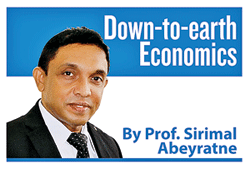“Fake smile”
View(s):
Tourism is a traditional service sector.
The world’s first industrialised country, the UK is today a “de-industrialised” economy. Over 80 per cent of employed people work in the service sector, contributing over 70 per cent of value addition to the GDP. Over the past 30 years, employment share in the industrial sector has declined from 30 per cent to 18 per cent, and the share of its value addition from 26 per cent of GDP to 17 per cent.
The world’s largest economy, the US, also tells us a similar story. Nearly 80 per cent of the employed people work in the service sector, generating about 77 per cent of value addition to GDP. In fact, this is by and large the same story of the developed world: They all have increasingly become service-oriented, or in other words, de-industrialised.
Post-industrial economy
This episode is a characteristic of ‘post-industrial’ economies that has been observed in a country’s development process. First the industrial sector expands with the increase in the share of industrial value addition to GDP as well as its employment share.
Employment share of the industrial sector also rises as people start moving away from the traditional agriculture sector to work in the growing industrial sector. The industrial sector has no limit to absorb labour inputs and grow fast. After reaching maturity as a developed economy, the industrialised countries enter the ‘post-industrial’ stage of development.
Post-industrial stage is a period of time in which the service sector starts to grow surpassing the industrial sector. As a result, the output and employment shares begin to change in favour of the service sector as in the UK, US and many other western industrialised countries.
Sources of change
First and foremost, the post-industrial stage is characterised by the expansion of economic activities based more on such inputs as information, communication, knowledge, and specialised skills more than the economic activities based on material inputs. In developed economies ICT, digitisation, designing, R&D, education, creativity and other knowledge and skills-based products dominate in contributing to the country’s GDP and employment.
 Secondly, there has been a shift in global production which has resulted in a change in industry-service combination as well. Multinational corporations (MNCs) in the western developed countries have learnt to slice up their vertical production processes into two categories of tasks: One category comprises tasks that require low-technology and low-skills, while the other category requires high-technology and high-skills. Then, they retained the latter for themselves in developed countries and outsourced the former to developing countries.
Secondly, there has been a shift in global production which has resulted in a change in industry-service combination as well. Multinational corporations (MNCs) in the western developed countries have learnt to slice up their vertical production processes into two categories of tasks: One category comprises tasks that require low-technology and low-skills, while the other category requires high-technology and high-skills. Then, they retained the latter for themselves in developed countries and outsourced the former to developing countries.
Developing countries which began to open their economies for FDI flows from developed countries were able to accommodate the outsourced tasks of the MNCs. Accordingly, there were global supply chains created by the MNCs, while the developing countries were able to hook up to them and get a slice of benefits from the MNCs.
Fly-by-night
Before 1995, the world FDI outflows were in the range of US$200-300 million. Ten years later, after 2005 during most of the years, they have escalated exponentially and remained in the range of $1,500-2,000. In addition, the world’s FDI flows increasingly turned towards developing countries, particularly in Asia.
The process also created a concern in both developed and developing countries. In developed countries, it was argued that there is nothing good about this change; in developing countries too, there was a feeling that it was a wrong type of expansion.
The episode was not without discontents in developed countries. They lost jobs to their own low-skilled and less-educated people, which were grabbed by the developing countries. The notion that “American jobs were stolen by China” created political tensions, which has caused dramatic policy changes too. However, it further enhanced an automation process, adding more fuel to service sector expansion.
In developing countries, it was argued at the time that the process generated the ‘footloose’ industries to set up “fly-by-night” companies and to exploit their cheap labour and other opportunities. In other words, the type of economic expansion in developing countries was not intended to get established and rooted there.
Smile curve
Whatever it is, the process of technological transformation in the world has caused the industrial sector too to depend more and more on service sectors. If you think of any sort of manufacturing product, more of its value addition along the value chain comes from the service sectors at both of its ‘pre-fabrication’ and ‘post-fabrication’ stages rather than at the ‘fabrication’ point.
The pre-fabrication (ex-ante) value addition of a product includes R&D, design, planning, communication, outsourcing, transport, supplies, finance, and maintaining input stocks. Then, the product fabrication takes place, at which value addition is relatively smaller. The post-fabrication (ex-post) value addition comes from such service activities as marketing, sales, customer care, transport, finance, communication and maintaining output stocks.
By depicting the value addition along the value chain of a product, the founder of Acer Inc., IT company headquartered in Taiwan, Stan Shih presented an interesting tool known as the “smile curve”. The smile curve represents value addition at different stages of the value chain, which depicts a line of a smile.
The curve appears like a “smile” when presented in a graph with vertical-axis showing value additions and horizontal-axis, the stages of value chain. With technological developments and global supply chain progress, service sector value addition has been increasing at both ends of the line, making the smile bigger. Simply, what it says is that in the modern times the service sector value addition is the biggest portion of the total value of manufacturing products.
Skipping the process
Some of the developing countries, even before becoming developed, have become more service-oriented. In fact, generally South Asian countries too are more service-oriented than the East Asian countries. We must also emphasise the fact that South Asia lags behind East Asia in terms of the timing of their development processes.
However, pre-mature service-orientation of developing countries has been a debatable issue among economists. According to one side of the argument, countries should first become industrialised and produce some ‘tangible things’ before changing to be service-oriented. This notion, by implication also demands for government’s selective intervention in navigating the development process by prioritising industrialisation.
The counter-argument is related to the world’s technological progress resulting in a “bigger smile” and the advent of global supply chains. The smile has become bigger with technological advancement because the service sector contribution to industry value chain rises. As a result, today’s industry growth requires more inputs from the service sector than it used to be earlier.
At the same time, value chains have become globalised so that service sector expansion in one country does not need to feed into industry growth in the same country. MNCs can find better locations for their ex-ante or ex-post service sectors, while industry fabrication or assembling can be set elsewhere. It is, therefore, natural to find that some countries are more service-oriented than others in this globalising world.
Smile, not genuine!
Surprisingly, Sri Lanka has also become a more service-oriented economy with the service sector value addition continuing to remain over 50 per cent of GDP. Before we conclude anything, however, it should be noted that Sri Lanka is not strongly connected to global value chains and not generating much foreign exchange from service exports. It shows that the Sri Lankan “smile” is not genuine.
It is the government that has made a significant contribution to service sector growth in Sri Lanka. While the government is primarily operating in the service sectors such as public administration, defence, social security, education and health care, its contribution is also greater in transport, aviation, port services, energy, utilities, telecommunication, financial service and real estate. They all are for the domestic market so that there are no foreign exchange earnings from these sectors.
Three of the services sectors that have made a significant growth in the past few years with private initiatives have been the ICT sector, business processing management (BPM), and tourism-related services. Sri Lanka has shown potentials for the expansion of these sectors, provided that there is an enabling business environment. They have the capacity to make the ‘smile curve’ genuine and to improve the country’s foreign exchange earnings.
(The writer is a former Professor of Economics at the University of Colombo and can be reached at sirimal@econ.cmb.ac.lk and follow on Twitter @SirimalAshoka).
Hitad.lk has you covered with quality used or brand new cars for sale that are budget friendly yet reliable! Now is the time to sell your old ride for something more attractive to today's modern automotive market demands. Browse through our selection of affordable options now on Hitad.lk before deciding on what will work best for you!


